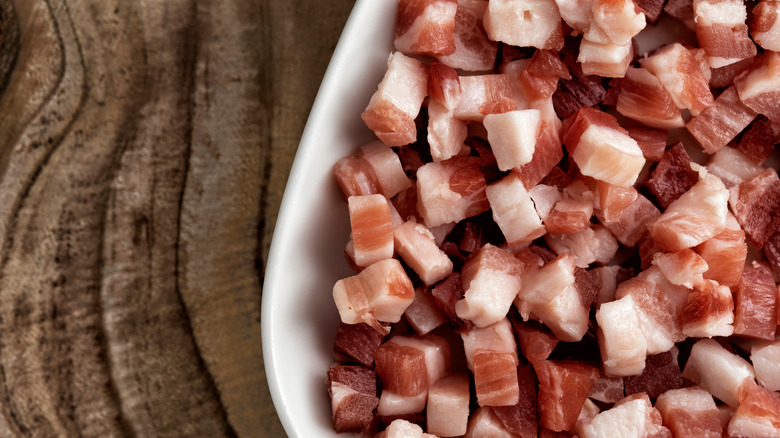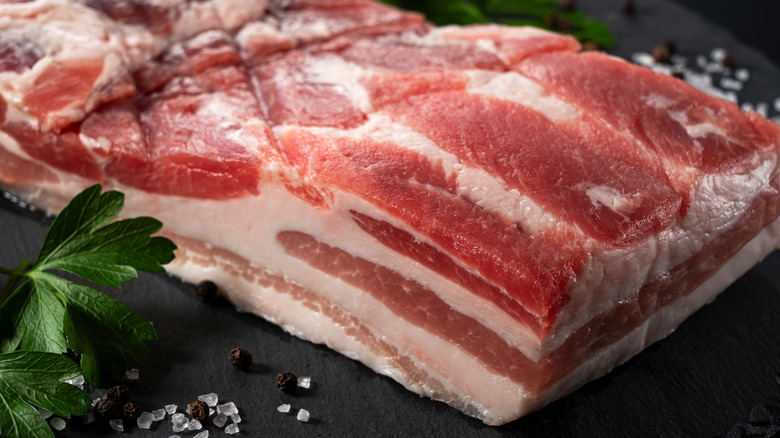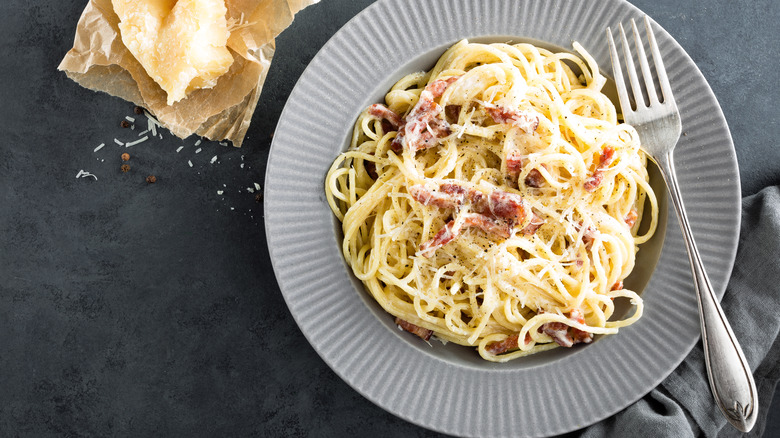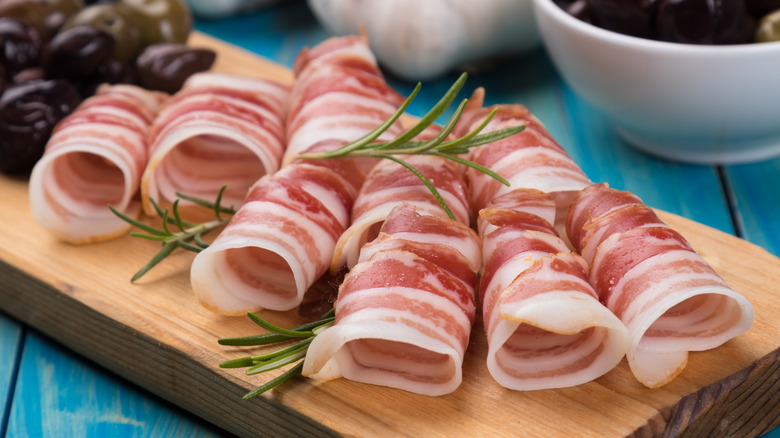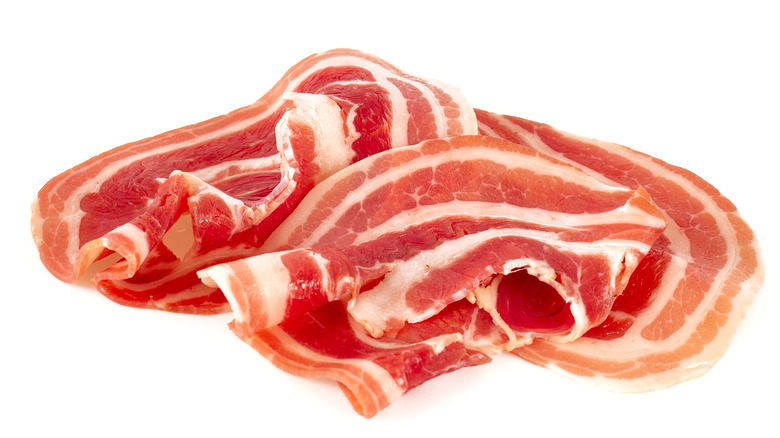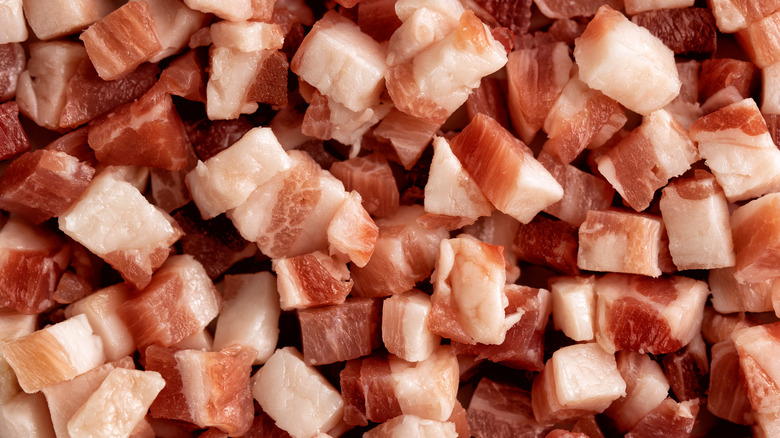What Is Pancetta And What Does It Taste Like?
A crispy cube of pancetta is one of the most purely delicious bites on earth (for carnivores, that is). Unctuous, salty, slightly fatty, and deeply porky, pancetta tastes a bit like a union of bacon and prosciutto — without any smokiness — and it elevates any dish that it's added to. When pancetta and pasta come together, for example, it's pure magic.
Pancetta and bacon are both made with pork belly, whereas prosciutto is made from a pig's back leg, as noted by MyRecipes. Of course, these three pork products can all be used interchangeably if you're in a pinch, but their flavors are certainly varied.
And while pancetta is often confused with similar pork products, crisp, perfectly rendered pancetta blows bacon out of the water any day, in our opinion. If pancetta isn't a part of your grocery rotation and a regular on your cheese boards, here's why it should be.
How is pancetta made?
A cured Italian pork product, pancetta is essentially pork belly that has been seasoned, salted, and lightly spiced, according to MyRecipes. It is pronounced pan-CHET-ta, as noted by La Cucina Italiana. Pancetta is often seasoned and cured with salt, sugar, pepper, juniper, bay leaves, nutmeg, and thyme, per Leite's Culinaria. How delicious does that sound?
MasterClass notes that pancetta's curing and drying process usually takes between three and four weeks. Once cured, the pork belly is seasoned and refrigerated, then washed, rolled, and slipped into a casing before being tied and hung.
Making pancetta from scratch takes patience and time. However, making pancetta doesn't require an abundance of ingredients — and aside from the pork belly itself, you may already have all of the other ingredients on hand. If you want to pursue making homemade pancetta as a culinary project of sorts, Christina's Cucina implores using the freshest pork belly available and notes that it's a multi-day process. Day one involves salting the belly, day two is rinsing and further preparing the pork with wine herbs, and spices, and then two-three weeks of drying and curing the pork belly. After this, your pancetta is ready to go.
What does pancetta taste like?
The easiest way to describe pancetta is that it's similar to bacon, but without the smokiness. Pancetta, like bacon, comes from pork belly, explains MyRecipes. But while bacon is smoked, pancetta is cured. And unlike bacon, pancetta is often eaten chilled and can be eaten raw.
"Pancetta receives its flavor from the curing spice blend used and the aging process," explains Volpi Foods. Whereas bacon often receives its flavor from the wood used in the smoking process, pancetta's flavor comes from the spices it's brined and aged in. Pancetta's flavor tends to be more subtle than bacon but a bit more forward than prosciutto.
While sliced pancetta is often served as part of a charcuterie board or as a salad topping, pancetta cubes are also a great addition to pasta recipes. If your dishes could use a salty kick, pancetta should be on your radar.
How to cook with pancetta
Pancetta is sold in large hunks, thinly sliced, or chopped into small bits. Depending on its preparation, pancetta can be used in a multitude of ways.
The small bits are an incredible inclusion in pasta dishes, particularly variations on a classic carbonara or all'amatriciana, which traditionally use guanciale. But we think a pancetta swap is permissible because guanciale can be a tricky ingredient to find. Serious Eats notes that there is actually is a form of smoked pancetta called pancetta affumicata, but you'd be mistaken if you think it's the same thing as bacon. According to the site, it tastes saltier and has a more seasoned flavor than American bacon.
In addition, pancetta lends amazing flavor to soups and stews, pairs well with green vegetables, and bolsters salads, pizzas, and more, according to BBC Food. It can also be added to a cold antipasto platter.
Where to buy pancetta
Many grocery stores now stock pancetta alongside other refrigerated meat options, such as salami, prosciutto, and bacon, so it shouldn't be too difficult for shoppers to find this porky, salty gem. Brands including Volpi Foods, Boar's Head, and even Target's Good & Gather line sell uncured and cubed pancetta.
But as Martha Stewart notes, pancetta tends to be more expensive than bacon and prosciutto because of the time-intensive curing process it undergoes. Even though you'll likely find it at your local supermarket without issue, you may want to consider it a specialty ingredient if you're trying to stick to a tight grocery budget.
A four-ounce package of store-brand pancetta is $5.49 at Target, while a 12-ounce package of diced pancetta from D'Artagnan will set you back $14.99. And if you really want an authentic cut of pancetta, Alma Gourmet has a 3.2-lb Pancetta Beretta for $42.95.
Nutritional information about pancetta
SFGate notes that pancetta, while not an especially good-for-you food, is perfectly suitable in smaller servings. It contains hardly any carbohydrates, sugar, or fiber but is also somewhat high in calories, clocking in around 212 calories per serving.
Pancetta offers approximately 1.5 grams of protein per serving, according to SFGate. However, it also contains around 22.5 grams of fat, including saturated, monosaturated, and polyunsaturated fats. It also tends to be relatively high in sodium, clocking in around 450 milligrams per serving, according to Boar's Head. Plus, some research has suggested that processed meats may not be good for you, and that includes pancetta.
If pancetta is the star of a dish, that particular meal may not be the most nutritionally sound. But if pancetta is merely a "side character," you should be good to go — you just might not want to eat it with every meal.
